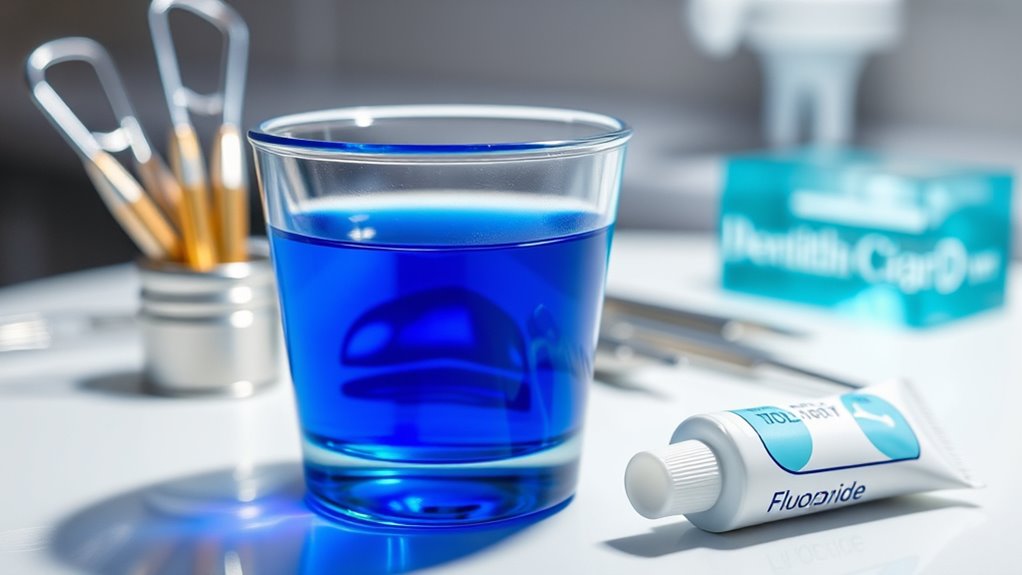Fluoride in drinking water is a safe, effective public health measure proven to reduce tooth decay and cavities. It’s supported by organizations like the CDC and WHO, with regulation ensuring safe levels that prevent harm like dental fluorosis. Some myths suggest it’s unnatural or unsafe, but scientific evidence confirms its benefits outweigh risks when properly monitored. If you want to understand how fluoride truly benefits your health and separates fact from fiction, keep exploring the evidence.
Key Takeaways
- Scientific evidence confirms that fluoride in water at regulated levels is safe and effectively prevents tooth decay.
- Myths claiming fluoride causes health problems are unsupported; excessive exposure may lead to mild dental fluorosis, a cosmetic issue.
- Major health organizations like CDC and WHO endorse water fluoridation as a safe and cost-effective public health measure.
- Fluoride naturally occurs in water sources; supplementation maintains optimal levels to improve dental health.
- Proper regulation ensures fluoride levels are safe, preventing overexposure while providing community-wide oral health benefits.

Have you ever wondered what fluoride really is and why it’s added to your drinking water? Water fluoridation is a public health practice where small amounts of fluoride are added to community water supplies to help improve dental health. The goal is simple: reduce tooth decay and prevent cavities across populations. This practice has been in place for decades, supported by numerous health organizations, including the CDC and the World Health Organization, as a safe and effective way to promote oral health. When you drink fluoridated water, fluoride interacts with your teeth’s enamel, making it more resistant to acid attacks from bacteria in your mouth. This process helps to remineralize early signs of decay before they turn into cavities, ultimately preserving your teeth and saving you from painful, costly dental procedures.
Water fluoridation is a straightforward, inexpensive method for community-wide dental health benefits. It reaches people of all ages, regardless of their socioeconomic status or access to dental care. Because fluoride is naturally present in some water sources, adding it to community water supplies ensures a consistent, controlled level that maximizes benefits while minimizing risks. The Centers for Disease Control and Prevention recognizes water fluoridation as one of the top public health achievements of the 20th century. It’s been proven to markedly decrease the incidence of cavities, especially in children, who are most vulnerable to dental decay. Moreover, it helps to reduce disparities in dental health by providing protection to those who may not have regular access to dental services or preventive care. Additionally, advances in appliance safety**** and regulation help ensure fluoride levels remain within safe limits for all community members.
However, despite its proven benefits, water fluoridation has faced myths and misconceptions. Some skeptics argue that it’s unnatural or could cause health problems, but scientific research overwhelmingly supports its safety when maintained at appropriate levels. The key is moderation and regulation; too much fluoride can lead to dental fluorosis, a cosmetic condition causing faint white spots on teeth, but this only occurs with excessive exposure. For most people, the levels used in water fluoridation are well below this threshold. Public health experts emphasize that fluoride in drinking water is a cost-effective, evidence-based strategy to promote dental health, especially in communities with limited access to dental care. So, the next time you turn on your tap, remember that this simple addition of fluoride aims to protect your teeth and ensure better oral health for everyone.
Frequently Asked Questions
Is Fluoride Safe for Children’S Developing Teeth?
You might wonder if fluoride is safe for your children’s developing teeth. The good news is, when used appropriately, fluoride strengthens tooth enamel and helps prevent cavities. It’s safe in recommended amounts, often found in toothpaste and community water. By ensuring your kids use the right fluoride products, you support healthy tooth enamel and cavity prevention, giving their teeth a strong foundation for a lifetime of good oral health.
Can Fluoride Cause Health Problems Beyond Dental Issues?
Imagine brushing your teeth and wondering if fluoride might cause health problems beyond dental issues. While fluoride toxicity is rare at recommended levels, excessive exposure could lead to health concerns like skeletal fluorosis or environmental impact, affecting ecosystems. However, scientific evidence shows that when used properly, fluoride is safe. Keep informed, follow guidelines, and you’ll minimize risks, ensuring both your health and the environment stay protected.
How Does Fluoride Interact With Other Dental Treatments?
When considering dental treatment interactions, you should know that fluoride generally has good fluoride compatibility with most dental procedures. It doesn’t interfere with common treatments like fillings or crowns, but it’s best to discuss your specific treatments with your dentist. They can guarantee that fluoride use complements your care plan and avoids any potential issues, helping you maintain ideal oral health without concerns about adverse interactions.
Are There Natural Sources of Fluoride Without Additives?
You can find natural sources of fluoride that contain mineral content without additives. For instance, certain types of water, like some well waters, naturally have fluoride levels. Additionally, foods like tea, seafood, and some fruits have mineral content with trace amounts of fluoride. These natural sources help support dental health without relying on added fluoride, making them a good choice if you’re seeking fluoride from natural sources.
What Are the Signs of Fluoride Overexposure?
You might notice signs of fluoride overexposure if you experience toxicity symptoms like dental fluorosis, which causes discoloration or mottling of teeth, or skeletal fluorosis, leading to joint pain and stiffness. Overexposure effects can include stomach upset, nausea, or vomiting. If you suspect you’ve had too much fluoride, it’s important to consult a healthcare professional promptly to assess your symptoms and prevent further health issues.
Conclusion
Remember, the truth about fluoride is like a gentle whisper—sometimes easy to overlook amid the noise. By seeking out reliable information, you’re choosing clarity over confusion. As you navigate the facts, trust that a well-informed perspective can quietly guide you toward healthier choices. Sometimes, the smallest details can make the biggest difference. Keep your curiosity alive, and let your understanding deepen softly, like the subtle glow of dawn—hopeful and true.








